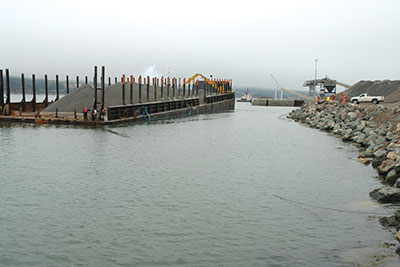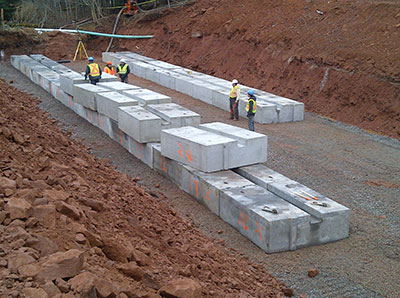
Features
Aggregates
Profiles
Bringing in the aggregate
Prince Edward Island has no quality aggregate of its own
April 21, 2014 By Carroll McCormick
Last October a 5.8-kilometre stretch of realigned Trans Canada highway
between Encounter Creek and New Haven, P.E.I. opened to traffic.
Last October a 5.8-kilometre stretch of realigned Trans Canada highway between Encounter Creek and New Haven, P.E.I. opened to traffic. The project consumed 77,000 tonnes of granular A aggregate for road base, 2,500 tonnes of riprap for slope protection and about 29,300 tonnes of aggregate to make the asphalt base coat. This summer it will lay down the asphalt seal coat, which will contain roughly 11,250 tonnes of aggregate. Every kilogram of this aggregate came from quarries off the Island.
 |
|
| Tugger pulling the Lablift away from Aulds Cove, N.S.
|
P.E.I. consists of overburden over sandstone bedrock. Usually yielding to backhoes and excavators, this soft bedrock, or “select borrow” is used for highway sub-base, local and seasonal roads. Wet weather transforms it into what locals call “baby poop.”
The Island does have small reserves of Class B crushed local gravel and Class C screened pit run. However, its use is on the decline, says Brian Profitt, general manager and secretary, Curran & Briggs Limited, Summerside. “It is maintenance gravel, mostly. We don’t have any good gravel. It is not very hard. There are maybe four to five quarries around the Island that would still be operating. We had one, but I closed it around six years ago. No one was using it and we couldn’t be bothered crushing it anymore.”
There is not even anything available now for making concrete, notes Jamie Reid, P.E.I. operations manager for OSCO Concrete, which operates MacLean’s Ready Mix in Montague and Souris and Schurman’s Concrete in Charlottetown and Summerside. “At one time there was Island stone and sand that was used in concrete but now these products don’t meet the testing requirements to be used in concrete. It used to be beach sand, but there are no more permits to mine it,” Reid says. None have been issued for the removal of beach sand since 2008 and the province ended commercial sand mining from PEI beaches for concrete in 2009.
The hard reality is that P.E.I. contractors work a supply chain that has trucks, barges and ships importing aggregate from numerous quarries in Nova Scotia, New Brunswick and Newfoundland.
N.S. quarries include those owned by New Glasgow-based S.W. Weeks Construction Ltd., MSD Enterprises Ltd. in Debert, Martin Marietta Canada in Aulds Cove and Lafarge Canada Inc., in Folly Lake. NB quarry companies include Modern Construction Ltd., and Saint John-based Gulf Operators Ltd., in Moncton. In Lower Cove, NF, south of Corner Brook, barges and ships take on aggregate from the enormous quarries owned by Atlantic Minerals Limited.
Last year Curran & Briggs trucked in approximately 28,000 tonnes of material, traveling from 140 to 155 kilometres to two Moncton-area quarries: Gayton and Gorge Road. The company also ordered in 45,000 tonnes of asphalt aggregate by barge, Profitt says. “We’ve been using two excavators and two loaders on the barge. The excavators scoop it up and put it in the trucks. We probably use 16 tractor-trailers with 35 or 36-foot boxes for an unloading. We can do that in 14-15 hours.
“For all [PEI] Transportation and Infrastructure Renewal contracts, the gravel is paid by the tonne supplied and installed. The contractor has to stockpile the aggregate and then reload, scale it and haul it to the project. You can have six to ten trucks hauling to a pile for two weeks or more to build up the material required.”
The Department of Transportation and Infrastructure Renewal does not generally bring in aggregate on its own, and it only maintains small maintenance stockpiles. “We have yards in Charlottetown, Bridgetown and Summerside,” says Darrell Evans, assistant director, capital projects, P.E.I. Department of Transportation and Infrastructure.
Trucks owned by OSCO ride the ferry between Wood Islands, P.E.I. and Caribou, N.S. to fetch aggregate from pits 35 to 40 kilometres off the ferry and from further afield, in Debert.
However, Reid notes, “We use ships whenever possible.” Canada Steamship Lines (CSL) brings in aggregate from Atlantic Minerals, at 35,000 to 40,000 tonnes of aggregate a pop. OSCO might order two or three shiploads per year, depending on inventory levels and market demand. “You can divide a ship and carry two or three different products – some for road base, some for concrete, etcetera,” Reid says.
 |
|
| The Granular A base and the concrete aggregate for this arch footing are brought in from other provinces. (Brian Simpson)
|
CSL unloads onto the wharves in Charlottetown and Summerside. The costs are substantial, Reid says. “Costs include the ship, wharf rental, security, 40-50 tractor trailers to haul away the aggregate, ship loading and unloading costs, stacking in the yards and cleanup.”
CSL has been moving stone to P.E.I. for at least 15 years, mostly from NF and, years ago, N.S. too. CSL currently uses the self-unloaders MV Atlantic Huron and MV Atlantic Erie. A round trip from Lower Cove to P.E.I., including loading and unloading, normally takes four and a half days. CSL makes regular shipments to PEI from April thru November.
Over the past five years, the Charlottetown Harbour Authority reports having received 5-10 lakers and 18-20 barges a year. Some of those barge visits were courtesy of the Labrador Spirit, owned by McKeil Marine. Capable of hauling 9,000 tonnes of aggregate, it picks up it loads in Aulds Cove.
Two other barges, the Lablift and the Arcticlift, capable of carrying 4,000 and 7,000 tonnes apiece, respectively, belong to Miller Shipping Ltd. in St. John’s. They bring Lower Cove aggregate across the Cabot Strait, from May to December, to four P.E.I. ports: Charlottetown, Summerside, Souris and Georgetown. “We might deliver as many as 30-40 barge loads a year, or as few as four or five,” says Pat Miller, president, Miller Shipping.
The barge and ship traffic into the ports is linked to the number of highway projects the Department of Transportation and Infrastructure Renewal has scheduled in any given year. “It could be anywhere from no barges in a year to as many as 20,” says Art MacDonald, port manager, Souris Harbour Authority. “We could receive anywhere from 20,000 to 100,000 tonnes of aggregate a year.”
In 2008 the Souris Harbour Authority ordered 70,000 tonnes of armour stone for breakwater work it needed, plus another roughly 5,000-tonne top up later on. Sault Ste. Marie-based Purvis Marine Limited delivered the 2008 shipments from Belledune, N.B. on the cargo vessel Yankcanuck.
Where the aggregate comes from is not a concern, but its properties must be known, Evans explains. “We do need to know the physical and chemical characteristics of the gravels being provided, and from which quarries they come from. The highway department knows the properties of the rock from many quarries and how it behaves, based on historical experience. But if it is coming from a new quarry, we have to know the characteristics of the aggregate in case we need to add additives to compensate for stripping.”
OSCO’s Jamie Reid certainly is not exaggerating when he says, “It is a lot different here.”
Print this page